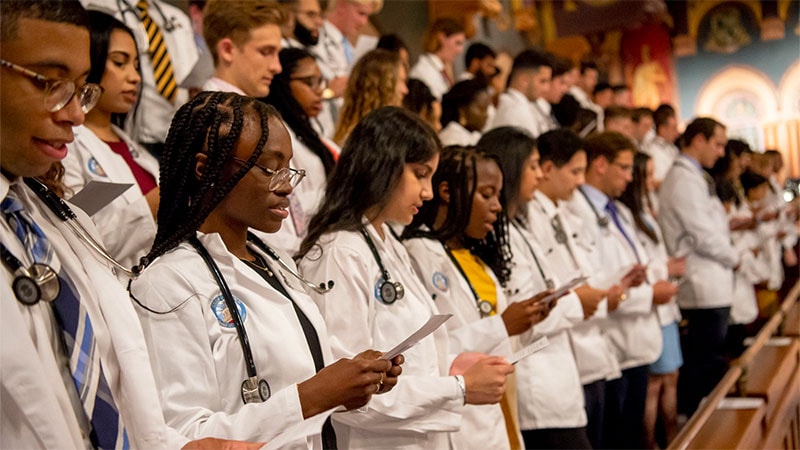The Hippocratic Oath is a long-standing tradition. But as the practice of medicine has evolved over the two millennia since the oath was created, the ancient text feels less and less applicable to today’s medical students.
Instead of swearing by Apollo, medical school administrators, including those at Columbia, Yale, Washington University, and Mount Sinai’s Icahn School of Medicine, are putting a contemporary spin on oaths, updating the language, and adding relevant context, often with input from the student body.
Although this approach sometimes encounters backlash, such as concerns about free speech, school leaders say it’s worthwhile to turn oath-taking into a more meaningful and personalized experience.
And without a national oath standard — neither the American Medical Association nor the American Association of Medical Colleges has an official oath requirement or position on adapting the Hippocratic Oath — many medical schools have already adopted a more modern pledge.
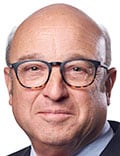
Dr Steven Scheinman
“The earliest version we have of the Hippocratic Oath dates to about 150 or 200 years after Hippocrates died, and no schools use that one,” says Steven Scheinman, MD, former dean at Geisinger Commonwealth School of Medicine in Pennsylvania and author of a 2018 study that analyzed oath content.
Now, schools typically use one of three primary oaths:
-
An “oath that bears the name of Hippocrates,” which is a newer interpretation of the traditional Oath of Hippocrates;
-
“A Modern Oath,” written in 1964 and often attributed to Dr Louis Lasagna; and
-
The Declaration of Geneva, first published in 1948 by the World Medical Association and updated in 2017.
When Scheinman conducted a textual analysis of 111 school oaths, he found that fewer than half used one of the three oaths during their commencement ceremonies.
Rather, the majority (about 53%) wrote a unique oath yearly or used one exclusive to the school, whereas just 9% of MD-granting schools recited customized commencement oaths in 1982 and about 25% in 2000.
Scheinman says white coat ceremonies have followed a comparable trend. In the same study, he found that most schools (70%) incorporated student-authored or school-specific white coat oaths, and just 11% used a variant of the Hippocratic Oath.
A Mix of Old and New
At the University of Pittsburgh Medical School, students recite a version of the Hippocratic Oath at white coat and graduation ceremonies, agreeing to “exercise my art solely for the cure of my patients” and “[hold] myself far aloof from wrong, corruption, and the tempting of others to vice.”
But, beginning with the class of 2024, students are taking the lead in penning a unique class oath.
In the weeks before orientation, incoming first-year students meet virtually to discuss the key elements their oath should contain, develop a word cloud, and select writers to compose the draft. They also review a patient case study highlighting physicians’ roles in global health.
Eventually, after several iterations, the oath is printed on reminder cards for the students to carry in their badge caddies and recite at the pinning ceremony before students embark on their clerkships.
Creating the class oath drives home the extent of physicians’ evolving responsibilities, says Chenits Pettigrew Jr, EdD, associate dean for diversity, equity, and inclusion at the university.
“We’re not replacing the Hippocratic Oath. We do this because we have a commitment to help students intentionally begin to acquire their professional identity, so they’re not just discovering doctoring by their observations and coursework; they’re given the opportunity to reflect on the commitment they’re making,” he says.
Specifically, the oath calls on students to honor their physical, mental, and emotional health, advocate for a more equitable healthcare system, and champion diversity in medicine and society.
Tito Onyekweli, a third-year Pitt med student involved in the writing process, says the traditional Hippocratic Oath is timeless, but modern oaths also have a place.
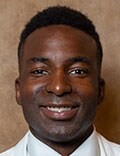
Tito Onyekweli
“We had to develop something that represented our entire class [so] we had intimate conversations with our peers to understand how their lived experiences have shaped them and will guide their practice,” he says. “Our new oath represents our values and what is most relevant to our generation of medical students.”
Similarly, incoming students at the University of Minnesota Medical School (UoM) collaborate with peers and faculty to write oaths for commencement and white coat ceremonies.
These oaths “build upon the intent of the Hippocratic Oath to promote humility, integrity, and beneficence” and “reflect core elements, values, and ethics the class aspires to uphold,” Kat Dodge, media relations manager for the university, said in a statement to Medscape Medical News.
At last year’s white coat ceremony, UoM students pledged to “care for patients with cultural competency and respect” and “strive for excellence through innovation in evidence-based medicine, respecting its utility, and acknowledging its limitations.”
Meanwhile, students at Georgetown University School of Medicine in Washington, DC recite an adaptation of the Hippocratic Oath at the white coat ceremony and graduation, vowing to “abstain from everything which may be harmful or dangerous to [patients]” and promising “to esteem and revere the teachers who have trained me in the science and art of medicine.”
However, in a new custom that reflects the changing times, several students subsequently take turns reading a line of the oath in their native language.
“For the class of 2026, we had a total of 24 students spanning 13 distinct languages volunteer to recite a line,” says Tom Guarino, MA, CHES, assistant dean for medical student support and well-being at Georgetown. He says that this practice embodies the school’s core value of “cura personalis,” or care of the whole person, and demonstrates a commitment to diversity and inclusion.
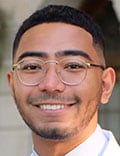
Badr Abdullah
Badr Abdullah, a Georgetown med student who emigrated from Oman 3 years ago, says that although it’s a small step, the updated ceremony was impactful. “Knowing that I proclaimed my commitment to service to all, including those who fall outside the English-speaking community, and that they can listen and connect to it directly, was incredibly empowering,” he says. “I hope that by encouraging linguistic diversity in our physicians, we can move toward providing more personalized and meaningful care to our patients.”
What’s an Oath Without an Education?
Despite there being less uniformity among customized oaths, many still share similarities. Respecting confidentiality, avoiding harm, and upholding the profession’s integrity were included in over 80% of texts reviewed in Scheinman’s study.
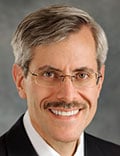
Dr Lauris Kaldjian
Lauris Kaldjian, MD, PhD, director of the bioethics and humanities program at the University of Iowa Carver College of Medicine (CCOM), found common themes in a 2018 analysis of oaths, with patient welfare, social justice, and nondiscrimination reflected in most texts.
While student-written oaths provide an opportunity for personalization, incorporating curricular content on oath-taking can deepen students’ understanding of the commitment and the foundational principles that remain.
For example, CCOM offers an ethics curriculum that underscores the virtues, such as beneficence, nonmaleficence, justice, and autonomy, outlined in the school’s distinct version of the Hippocratic Oath. They also offer an elective course that delves into the history of oath-taking.
When Scheinman first came to Geisinger in 2012, the school needed an oath for its inaugural class, so he assigned the responsibility to the senior students. During match week, the students studied existing oaths and their historical context.
Based on their findings, a delegation of students wrote an oath that included a commitment to “abandon my prejudices to walk with [my patients] on their journey through life and its pivotal transitions,” says Scheinman. The oath was later adopted as the school’s customary commencement oath, and Scheinman continued to lead an annual seminar on oath-taking throughout his tenure.
Unfortunately, Scheinman said, his study found that less than half of all schools polled integrate oath-related content into their curriculum, usually as a professionalism or bioethics course or through oath-writing sessions and lectures.
“In half of the schools, the only time the students think about an oath is when they stand up at commencement and take an oath that somebody else is telling them to take. They do it for the first time, and then they may never revisit that oath,” he says.
Regardless of the pledge adopted, Kaldjian says that “medical education [should establish] a meaningful correspondence between what is professed and what is practiced.”
Steph Weber is a Midwest-based freelance journalist specializing in healthcare and law.
For more news, follow Medscape on Facebook, Twitter, Instagram, YouTube, and LinkedIn
Source: Read Full Article






